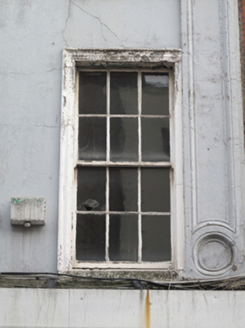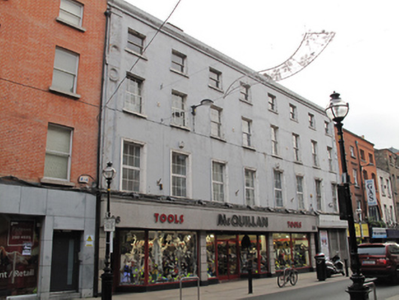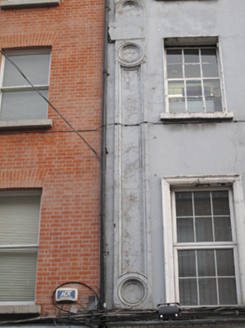Survey Data
Reg No
50010432
Rating
Regional
Categories of Special Interest
Architectural
Previous Name
Joshua Edmundson
Original Use
House
In Use As
Shop/retail outlet
Date
1760 - 1780
Coordinates
315364, 234465
Date Recorded
22/11/2011
Date Updated
--/--/--
Description
Terraced group of four two-bay four-storey former houses, built c.1770 as two pairs and amalgamated c.1870 for commercial use, southernmost two bays now constituting separate property, with replacement shopfronts to ground floor one spanning six northern bays. Southernmost building has original M-profile slate roof, hipped to north and having pair of chimneystacks to centre. Northern two buildings have replacement pie-ended slate roof with central chimneystack. All roofs hidden behind slightly projecting, rendered parapet wall with moulded cornice, and with replacement uPVC hopper and downpipe breaking through to north end. Painted rendered walls, with painted Roman cement flat-panelled pilasters to each end of group, with roundel details. Square-headed diminishing window openings, larger and at different levels to southern two buildings, with painted stone sills throughout, patent rendered reveals to second and third floors, and architrave surrounds to first floor. One-over-one pane timber sliding sash windows to top floor, six-over-six pane to second floor and replacement uPVC to first floor.
Appraisal
The roof plan to this building clearly indicates its origin as several houses, amalgamated in the late nineteenth century, with a refaced facade with applied stuccowork. The moulded architraves which adorn the first floor, along with banded quoin detailing, are indicative of mid-nineteenth-century detailing. The unified façade treatment was applied in the late nineteenth century to create Joshua Edmondson & Company's hardware store and the building continues to have this use. The group forms part of the palimpsest character of this historic streetscape, which was was laid out in the late seventeenth century by Humphrey Jervis as a prestigious residential street and named after Arthur Capel, Earl of Essex. By 1800 the street had become one of the city’s principal commercial thoroughfares and the current plot ratios reflect the buildings of that period.





